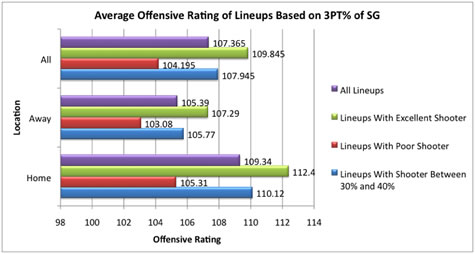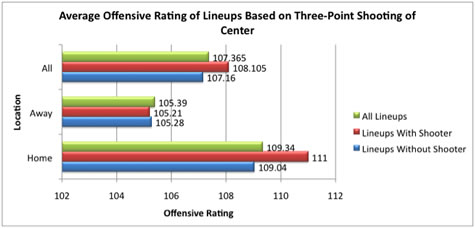| Basketball-Statistics.com | Innovative Stats and Analysis | |||||||||||
|
|||||||||||
|
|
by Jon Nichols 7/26/09 Not too long ago I ran a couple of studies measuring the effectiveness of three-point shooting ability for point guards (http://basketball-statistics.com/howtheshootingabilitiesofpointguardsaffectoffenses.html) and small forwards (http://basketball-statistics.com/howtheshootingabilitiesofsmallforwardsaffectoffenses.html). The general idea wouldn’t be complete without a look at the remaining three positions. Using the lineup data at http://www.basketballvalue.com, I’ve split the lineups into three groups: those featuring a player from each position who shoots 40% or better on threes, those featuring one who shoots 30% or less, and the remainder. For each group, I’ve calculated the average Offensive Rating. In addition, the lineups are split between those at home and those on the road. The results for shooting guards are in the graph below:
And here are the frequencies for that position:
The results for shooting guards are very similar to those of point guards. Not surprisingly, having a player at those positions with the ability to shoot accurately from long distance greatly improves the success of your offense. One thing that is different is the frequencies. As you can see above, not too many shooting guards shoot less than 30% on three-pointers. However, the frequencies for shooters above 40% aren’t too high, either. Up next are the power forwards. For this position, I had to alter the criteria a little bit. To ensure adequate sample sizes, I had to change the definition of great shooters to those above 38% on threes, and poor shooters to those below 28%. It’s a minor change, but it’s fair because of the relative lack of big men who can shoot well from the outside.
At home, it doesn’t seem to matter if your power forward can shoot. The four categories are essentially identical. On the road, it appears that your team gets a significant boost if your power forward can shoot threes at a higher rate than 28%. He doesn’t have to be spectacular in this area; he just needs to be adequate. Finally, let’s take a look at the centers. I had to make yet another change for this position. Even fewer centers can shoot three-pointers accurately, so I removed the cutoff points altogether. Instead, I classified centers as shooters or non-shooters. The difference was whether or not the player had a large amount of three-point attempts. Of course, by changing the criteria from accuracy to attempts, I changed the dynamic. However, given the scarcity of great-shooting centers, it was necessary.
The center results may not be directly comparable to those of power forwards because of the different criteria, but they appear to be the inverse. On the road, it doesn’t matter if your center likes to shoot from the outside. At home, however, it is beneficial. Either way, the differences aren’t significant enough and the sample sizes too small for me to make a definitive statement. So there you have it. To recap:
Copyright © 2009 Basketball-Statistics.com |
|||||||||





